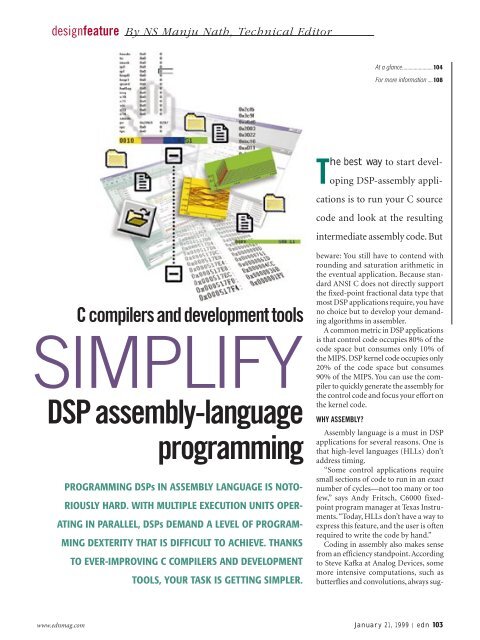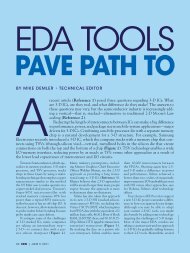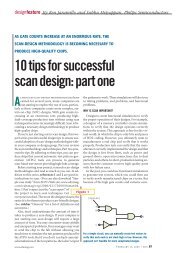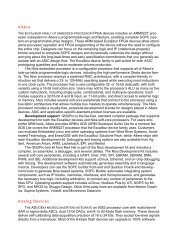designfeature DSP assembly language - EDN
designfeature DSP assembly language - EDN
designfeature DSP assembly language - EDN
Create successful ePaper yourself
Turn your PDF publications into a flip-book with our unique Google optimized e-Paper software.
<strong>designfeature</strong> By NS Manju Nath, Technical Editor<br />
C compilers and development tools<br />
SIMPLIFY<br />
<strong>DSP</strong> <strong>assembly</strong>-<strong>language</strong><br />
programming<br />
www.ednmag.com<br />
PROGRAMMING <strong>DSP</strong>s IN ASSEMBLY LANGUAGE IS NOTO-<br />
RIOUSLY HARD. WITH MULTIPLE EXECUTION UNITS OPER-<br />
ATING IN PARALLEL, <strong>DSP</strong>s DEMAND A LEVEL OF PROGRAM-<br />
MING DEXTERITY THAT IS DIFFICULT TO ACHIEVE. THANKS<br />
TO EVER-IMPROVING C COMPILERS AND DEVELOPMENT<br />
TOOLS, YOUR TASK IS GETTING SIMPLER.<br />
At a glance........................104<br />
For more information ....108<br />
The best way to start developing<br />
<strong>DSP</strong>-<strong>assembly</strong> applications<br />
is to run your C source<br />
code and look at the resulting<br />
intermediate <strong>assembly</strong> code. But<br />
beware: You still have to contend with<br />
rounding and saturation arithmetic in<br />
the eventual application. Because standard<br />
ANSI C does not directly support<br />
the fixed-point fractional data type that<br />
most <strong>DSP</strong> applications require, you have<br />
no choice but to develop your demanding<br />
algorithms in assembler.<br />
A common metric in <strong>DSP</strong> applications<br />
is that control code occupies 80% of the<br />
code space but consumes only 10% of<br />
the MIPS. <strong>DSP</strong> kernel code occupies only<br />
20% of the code space but consumes<br />
90% of the MIPS. You can use the compiler<br />
to quickly generate the <strong>assembly</strong> for<br />
the control code and focus your effort on<br />
the kernel code.<br />
WHY ASSEMBLY?<br />
Assembly <strong>language</strong> is a must in <strong>DSP</strong><br />
applications for several reasons. One is<br />
that high-level <strong>language</strong>s (HLLs) don’t<br />
address timing.<br />
“Some control applications require<br />
small sections of code to run in an exact<br />
number of cycles—not too many or too<br />
few,” says Andy Fritsch, C6000 fixedpoint<br />
program manager at Texas Instruments.“Today,<br />
HLLs don’t have a way to<br />
express this feature, and the user is often<br />
required to write the code by hand.”<br />
Coding in <strong>assembly</strong> also makes sense<br />
from an efficiency standpoint. According<br />
to Steve Kafka at Analog Devices, some<br />
more intensive computations, such as<br />
butterflies and convolutions, always sug-<br />
January 21, 1999 | edn 103
<strong>designfeature</strong> <strong>DSP</strong> <strong>assembly</strong> <strong>language</strong><br />
gest themselves as logical candidates for<br />
coding in <strong>assembly</strong>. In digital-communication<br />
applications, FIR or IIR filters lend<br />
themselves well to C with intrinsic functions,<br />
but you still need to program Viterbi<br />
or Reed-Solomon decoders in <strong>assembly</strong>,<br />
according to Kevin Stone, product<br />
engineer at ZSP Corp.<br />
<strong>DSP</strong> ARCHITECTURES INFLUENCE CODE<br />
Detailed knowledge of the target architecture<br />
is a must for developing efficient<br />
application code, especially knowing<br />
which “dirty tricks” you can use to<br />
take advantage of the architecture’s<br />
strengths. Programming <strong>DSP</strong>s becomes<br />
easy when the architecture and programming<br />
model of a <strong>DSP</strong> are wellstructured.<br />
For example, a <strong>DSP</strong> that has<br />
a very orthogonal instruction set (that is,<br />
all commands work on all registers) is<br />
easier to program and optimize than a<br />
<strong>DSP</strong> whose commands work only on specific<br />
ALU registers. For example, Analog<br />
Devices’A<strong>DSP</strong>-21062 Super Harvard Architecture<br />
Computer (SHARC) <strong>DSP</strong> features<br />
three independent parallel computation<br />
units: the ALU, the multiplier, and<br />
the shifter. Single multifunction instructions<br />
execute parallel ALU and multiplier<br />
operations.<br />
The <strong>DSP</strong> features an enhanced Harvard<br />
architecture in which the datamemory<br />
bus transfers data and the program-memory<br />
bus transfers both<br />
instructions and data. A general-purpose,<br />
10-port, 32-bit data-register file, combined<br />
with the A<strong>DSP</strong>-<br />
21000 Harvard architec-<br />
ture, allows unrestricted<br />
data flow between<br />
computation units<br />
and internal memory. The<br />
A<strong>DSP</strong>-21062 includes an<br />
on-chip instruction cache<br />
that enables three-bus operation<br />
for fetching an instruction<br />
and two data values.<br />
The cache selectively<br />
caches only those instructions<br />
whose fetch operations<br />
conflict with program-memory-bus<br />
data<br />
accesses.<br />
This scheme allows fast<br />
execution of core, looped<br />
operations, such as multiply-accumulate<br />
(MAC) instructions<br />
and FFT butterfly<br />
processing. The device’s<br />
Figure 1<br />
AT A GLANCE<br />
3Programming <strong>DSP</strong>s in mnemonics or<br />
algebraic <strong>assembly</strong> <strong>language</strong> is a necessity<br />
because no better way exists to generate<br />
compact code and ensure faster execution<br />
of application software.<br />
3Depending on the application and timeto-market<br />
considerations, you have to<br />
proceed carefully with your <strong>DSP</strong> application<br />
development.<br />
3Now, rather than develop <strong>assembly</strong><strong>language</strong><br />
modules from the ground up, you<br />
can use a C compiler to generate <strong>assembly</strong><br />
code.<br />
3You can further optimize and debug the<br />
C compiler-generated <strong>assembly</strong> code by<br />
using development tools supplied by <strong>DSP</strong><br />
vendors and third-party developers.<br />
48-bit instruction word accommodates a<br />
variety of parallel operations for concise<br />
coding. For example, the A<strong>DSP</strong>-21062<br />
can execute a multiply, an add, a subtract,<br />
and a branch all in a single instruction.<br />
ZSP Corp’s ZSP16401 is a 16-bit fixedpoint<br />
<strong>DSP</strong> based on a superscalar architecture<br />
(register-based with multiple execution<br />
units) that employs a five-stage<br />
pipeline. The <strong>DSP</strong> features two ALUs and<br />
two MAC units, which use a 16-bit register-operand<br />
file for their source and<br />
The integrated development environment debugger window of the ZSP164xx<br />
<strong>DSP</strong> lets you quickly complete code debugging. ZSP’s Profiler (also known<br />
as Simulator) gives you valuable information about how the instructions are<br />
grouped so that you can optimize the code and thus achieve maximum<br />
performance.<br />
destination. This register-rich architecture<br />
avoids accumulator bottlenecks and<br />
helps reduce immediate memory accesses.<br />
Further, you can use data memory as<br />
a general-purpose, scratchpad resource<br />
while reading and writing to device registers.<br />
There are no restrictions on reading<br />
and writing to data memory, unlike<br />
the segregated read and read/write memory<br />
scheme found in traditional <strong>DSP</strong>s.<br />
Code development for the device has<br />
the look and feel of development for a �C<br />
<strong>assembly</strong> code (Figure 1). For example,<br />
you can write <strong>assembly</strong>-<strong>language</strong> routines<br />
as a linear sequence of instructions.<br />
You can also combine instructions that<br />
specify one or two operations with other<br />
instructions for parallel execution, but<br />
the code contains no scheduling information.<br />
Thanks to the device’s pipelinecontrol<br />
unit, which schedules as many as<br />
four instructions for execution within the<br />
same clock cycle, you need not worry<br />
about scheduling parallel execution. This<br />
feature is a major benefit, because it allows<br />
you to concentrate on the algorithm<br />
and its implementation rather than on<br />
the <strong>DSP</strong>’s architecture.<br />
THE SKILL FACTOR<br />
The inherent nature of <strong>DSP</strong> applications<br />
means that certain programming<br />
skills are unique to <strong>DSP</strong>-<strong>assembly</strong> programming.<br />
Coding <strong>DSP</strong> algorithms is<br />
mathematically intensive. Mapping those<br />
models onto a <strong>DSP</strong>’s architecture is a skill<br />
unique to <strong>DSP</strong> <strong>assembly</strong> programmers.<br />
“You often trade off when<br />
coding an algorithm that requires<br />
41 MIPS onto an architecture<br />
that can deliver<br />
only 40 MIPS,” says Analog<br />
Devices’ Kafka.“In such situations,<br />
a thorough understanding<br />
of the math involved<br />
in the algorithm will<br />
help the <strong>assembly</strong> programmer<br />
modify the algorithm so<br />
that it requires fewer MIPS<br />
while still delivering the desired<br />
results.”<br />
According to Kafka, <strong>DSP</strong><strong>assembly</strong><br />
programming also<br />
requires that you understand<br />
instruction stalls. Instruction<br />
stalling is important because<br />
it helps you optimize <strong>assembly</strong>.<br />
“Stalling” means that a<br />
previous instruction delays<br />
the next instruction because<br />
104 edn | January 21, 1999 www.ednmag.com
<strong>designfeature</strong> <strong>DSP</strong> <strong>assembly</strong> <strong>language</strong><br />
that instruction needs the previous result<br />
to execute. For example, in the following<br />
code fragment, the Motorola <strong>DSP</strong>56300<br />
introduces two clock cycles after the first<br />
instruction but before executing the second<br />
instruction to ensure that the address<br />
register “inputPtr” contains valid data.<br />
You can optimize the above software by<br />
inserting another instruction between<br />
the following two instructions:<br />
MOVE #InputBufferBase, inputPtr<br />
MOVE Input_Mem:(inputPtr)+,<br />
inputBuf<br />
Kafka believes that <strong>DSP</strong>-<strong>assembly</strong> programmers<br />
should also understand:<br />
● various code optimizations, for<br />
example, software pipelining (execution<br />
of operations from different<br />
iterations of the loops in parallel);<br />
● finite-arithmetic effects, such as<br />
overflow, saturation and cumulative<br />
effects;<br />
● memory architectures, such as<br />
modified-Harvard and banked, and<br />
how to exploit them;<br />
● special architectural features, such<br />
as circular buffers and bit-reverse<br />
addressing, and how to exploit<br />
them;<br />
● required accuracy and precision,<br />
which allows you to use look-up<br />
tables or seed values for iterative<br />
approximations;<br />
● math “tricks,” which can reduce<br />
explicit operations; for example,<br />
divide by 2 is a simple shift; and<br />
● how to represent scalar fractional<br />
data.<br />
ALGEBRAIC OR MNEMONICS?<br />
Two methods exist for developing<br />
assembler code: One is by traditional<br />
mnemonic-assemblers;<br />
the other is by algebraic assembler.<br />
Analog Devices asserts that its algebraic<br />
<strong>assembly</strong> syntax helps you<br />
develop a clear understanding of<br />
<strong>DSP</strong> algorithms and their underlying<br />
mathematical models. Kafka<br />
says that intuitive (algebraic) syntax<br />
is important in developing<br />
<strong>DSP</strong> applications. He asserts that<br />
the code is easier to write, easier to<br />
maintain, and easier to read than<br />
a mnemonics-based syntax. See<br />
the listing below for a quick comparison:<br />
Algebraic: A<strong>DSP</strong>-21060 instruc-<br />
tions to find the maximum of two<br />
operands:<br />
R7=MAX (R5, R6)<br />
Mnemonics: TMS320C40 instructions to<br />
find the maximum of two operands:<br />
LDF R6, R7<br />
CMPF R5, R7<br />
LDFLT R5, R7<br />
For more source code, comparing<br />
Analog Devices algebraic syntax for<br />
the SHARC with the mnemonic syntax<br />
for Texas Instruments’ TMS320C40,<br />
go to www.analog.com/techsupt/<br />
application_notes/AN-403.pdf. According<br />
to Reid Tatge, a distinguished member<br />
of the technical staff in the Software<br />
Development Systems Group at Texas Instruments,<br />
using algebraic-<strong>assembly</strong> code<br />
versus using mnemonics-<strong>assembly</strong> code<br />
is mostly a matter of personal preference.<br />
Tatge sees no inherent advantages of either<br />
approach, either in the implementation<br />
of the algorithm in the assembler<br />
or in the programmer’s use of or ability<br />
to read a program.<br />
Tatge argues that, although most of the<br />
instructions in RISC-like architectures<br />
map nicely to a familiar “algebraic”form,<br />
algebraic <strong>assembly</strong> gets complicated<br />
when you are handling instructions that<br />
affect status bits. Also, algebraic assemblers<br />
often use esoteric operations by inventing<br />
syntax for common types of <strong>DSP</strong><br />
operations, such as saturated math, bitreversed<br />
math, circular addressing, and<br />
add with carry. Algebraic assemblers typically<br />
revert to a mnemonics or functional<br />
form for these special instructions:<br />
r0 = add_saturate (r1,r2)<br />
With the TMS320C54x <strong>DSP</strong>s, you can<br />
generate code with either an algebraic or<br />
a mnemonics/assembler. Tatge says there<br />
is a 1-to-1 translation between mnemonics<br />
and algebraic <strong>assembly</strong> on the C54x,<br />
so users are not penalized in cycle count<br />
or code size, regardless of which format<br />
they prefer.<br />
DEVELOPMENT TOOLS FOR <strong>DSP</strong> ASSEMBLY<br />
Debugging tools for <strong>assembly</strong>-<strong>language</strong><br />
development are getting more sophisticated.<br />
The ZSP164xx <strong>DSP</strong> provides<br />
you with an integrated development environment<br />
(IDE) that allows you to<br />
rapidly and smoothly complete debugging.<br />
ZSP’s Profiler (also known as Simulator)<br />
gives valuable information on<br />
how the instructions are grouped so that<br />
an <strong>assembly</strong> programmer can optimize<br />
the code to the fullest extent and achieve<br />
maximum performance (Figure 1).<br />
Analog Devices’ Visual<strong>DSP</strong> (Figure 2)<br />
introduces an easy-to-use project management<br />
environment, comprising an<br />
IDE and a debugger. Visual<strong>DSP</strong> lets you<br />
manage projects from start to finish from<br />
within one integrated interface. Because<br />
the project-development and debugging<br />
environments are integrated, you can easily<br />
move between editing, building, and<br />
debugging activities.<br />
The IDE includes access to the SHARC<br />
<strong>DSP</strong> C compiler, C runtime library, assembler,<br />
linker, loader, simulator, and<br />
splitter. Visual<strong>DSP</strong>’s debugger has many<br />
features that greatly reduce debugging<br />
time. You can view C source interspersed<br />
with the resulting <strong>assembly</strong> code,<br />
profile execution of a range of in-<br />
Figure 2<br />
Visual<strong>DSP</strong>’s debugger session displays a locals window, a<br />
mixed C/<strong>assembly</strong> source window, an active-register-file<br />
window, and an active data-address-generator window. The<br />
debugger supports C, <strong>assembly</strong> and mixed C, and <strong>assembly</strong>expression<br />
evaluation.<br />
structions in a program, set<br />
simulated watch points on<br />
hardware and software registers,<br />
program and data memory, and<br />
trace instruction execution and<br />
memory accesses.<br />
The C compiler generates efficient<br />
code that is optimized for both<br />
code density and execution time.<br />
The compiler allows you to include<br />
<strong>assembly</strong>-<strong>language</strong> statements inline.<br />
This feature means that you<br />
can program in C and still use <strong>assembly</strong><br />
for time-critical loops. You<br />
can also use pretested math, <strong>DSP</strong>,<br />
and C runtime-library routines to<br />
shorten your time to market. A cy-<br />
106 edn | January 21, 1999 www.ednmag.com
<strong>designfeature</strong> <strong>DSP</strong> <strong>assembly</strong> <strong>language</strong><br />
cle-accurate, instructionlevel<br />
simulator lets you simulate<br />
your application in real<br />
time. Also, the Visual<strong>DSP</strong><br />
tool features a well-defined<br />
application programming<br />
interface (API). Third-party<br />
products, runtime operating<br />
systems, emulators, HLL<br />
compilers, and multiprocessor<br />
hardware can interface<br />
seamlessly with Visual<strong>DSP</strong><br />
and thereby simplify tool integration.Visual<strong>DSP</strong><br />
follows<br />
the COM API format. Two<br />
API tools, Target Wizard and<br />
API Tester, are also available.<br />
You can find links to third<br />
parties that support Analog’s<br />
<strong>DSP</strong> product lines at www.<br />
analog.com/support/3rd_<br />
party/third_party.html.<br />
Texas Instruments TMS-<br />
320C6x <strong>DSP</strong> features two<br />
datapaths—each with 16 32-bit registers—shared<br />
by eight functional units.<br />
The C6x is a very-long-instructionword<br />
(VLIW) processor; a composite<br />
instruction (line), formed by concatenating<br />
n short instructions, controls its<br />
functional units. In the C6x, the short<br />
instructions are 32 bits wide, and the<br />
line consists of a maximum of eight<br />
32-bit instructions. Therefore,<br />
the C6x packs instructions to avoid inefficient<br />
use of program memory.<br />
FOR MORE INFORMATION...<br />
Instruction packing may result in<br />
alignment restrictions between lines and<br />
the physical-memory organization. In<br />
the C6x, the program is organized as<br />
eight instruction lines, or fetch packets.<br />
You may divide each fetch packet into<br />
groups of instructions or “execute packets,”which<br />
are issued in parallel. The C6x<br />
is restricted because the execute packet<br />
must be within an eight-word boundary.<br />
Every fetch packet must start with an execute<br />
packet. This stipulation implies that<br />
For information on products such as those discussed in this article, circle the appropriate numbers<br />
on the Information Retrieval Service card or use <strong>EDN</strong>’s InfoAccess service. When you contact<br />
any of the following manufacturers directly, please let them know you read about their products<br />
in <strong>EDN</strong>.<br />
Analog Devices<br />
Norwood, MA<br />
1-781-329-4700<br />
fax 1-781-326-8703<br />
www.analog.com/dsp/<br />
Circle No. 301<br />
<strong>DSP</strong>ecialists GmbH<br />
Berlin, Germany<br />
+49 30 467 805 60<br />
fax +49 30 467 805 99<br />
www.<strong>DSP</strong>ecialists.de<br />
Circle No. 302<br />
Texas Instruments<br />
Dallas, TX<br />
1-972-644-5580<br />
fax 1-972-480-7800<br />
www.ti.com<br />
Circle No. 303<br />
ZSP Corp<br />
Santa Clara, CA<br />
1-408-450-6207<br />
fax 1-408-986-1687<br />
www.zsp.com<br />
Circle No. 304<br />
The Code Composer IDE features the Assembly Optimizer tool. Using the<br />
Assembly Optimizer, you can write conventional-looking C6000 <strong>assembly</strong><br />
code without bothering with parallel instructions, instruction latencies, or<br />
register usage. The Assembly Optimizer then schedules the instructions,<br />
taking into account the C6000’s parallel architecture.<br />
SUPER CIRCLE NUMBER<br />
For more information on the<br />
products available from all of<br />
the vendors listed in this box,<br />
circle one number on the reader<br />
service card. Circle No. 305<br />
you must pad fetch packets<br />
that do not end with an execute<br />
packet with no-op-<br />
Figure 3<br />
eration instructions. Furthermore,<br />
the need to track<br />
various functional units in a<br />
VLIW architecture can rapidly<br />
overwhelm a <strong>DSP</strong> programmer.<br />
To help application developers,<br />
TI has introduced the<br />
concept of “linear” <strong>assembly</strong><br />
<strong>language</strong>. Linear <strong>assembly</strong> <strong>language</strong><br />
allows you to write <strong>assembly</strong><br />
<strong>language</strong> without regard<br />
to registers and pipeline<br />
behavior, significantly easing<br />
the task of writing low-level<br />
code. An Assembly Optimizer,<br />
which performs many compilerlike<br />
optimizations, processes<br />
linear <strong>assembly</strong> by assigning<br />
registers and scheduling<br />
the instructions, effectively<br />
handling all the “hard” problems<br />
associated with writing code for a<br />
pipelined processor (Figure 3).<br />
TI claims that the C6000 compiler offers<br />
an average improvement in execution<br />
speed; it is three times faster than<br />
state-of-the-art fixed-point <strong>DSP</strong> C compilers.<br />
The C compiler accepts ANSI C<br />
source code and produces efficient C6000<br />
<strong>assembly</strong>-<strong>language</strong> source code, performing<br />
a variety of optimizations to improve<br />
the efficiency of the compiled code.<br />
The compiler incorporates four levels of<br />
state-of-the-art generic and target-specific<br />
optimizations. The level of optimizations<br />
is selectable.<br />
Optimizations include those features<br />
specific to the TMS320C6201 processor,<br />
such as software pipelining, if conversion/predicated<br />
execution, memory-address<br />
cloning, memory-address-dependence<br />
elimination, branch optimizations/control-flow<br />
simplification, alias<br />
disambiguation, copy propagation, common<br />
subexpression elimination, redundant<br />
assignment elimination, loop-induction-variable<br />
optimizations/strength<br />
reduction, loop rotation, loop invariant<br />
code motion, inline expansion of function<br />
calls, register tracking/targeting, and<br />
cost-based register allocation. For more<br />
information, visit TI’s <strong>DSP</strong> third-party<br />
Web site (www.ti.com/sc/docs/dsps/<br />
develop/3party.htm).<br />
Even with all these development tools,<br />
108 edn | January 21, 1999 www.ednmag.com
<strong>designfeature</strong> <strong>DSP</strong> <strong>assembly</strong> <strong>language</strong><br />
you need a good design methodology to<br />
develop consistent, top-quality <strong>assembly</strong><br />
code. ZSP’s Stone suggests the following<br />
algorithm as a general method for generating<br />
consistent, top-quality <strong>assembly</strong><br />
code:<br />
Design for correctness:<br />
1. Clearly define and document<br />
problem. (Anticipate problems<br />
beforehand.)<br />
2. Start with a fixed-point C model.<br />
Document code and anticipate areas<br />
that you may need to write in <strong>assembly</strong>.<br />
3. Compile C code; generate <strong>assembly</strong>.<br />
4. Verify <strong>assembly</strong> in system.<br />
Possibility 1:<br />
5. Optimize C code by adding intrinsics,<br />
library functions, or <strong>assembly</strong><br />
routines with C wrappers.<br />
6. Verify C+ASM.<br />
7. Go to 5.<br />
Possibility 2:<br />
5. Write ASM.<br />
6. Verify ASM.<br />
7. Optimize ASM.<br />
8. Go to 6.<br />
For developing high-quality <strong>assembly</strong><br />
code, Raymond Horn, CEO of <strong>DSP</strong>ecialists,<br />
a German design house specializing<br />
in <strong>DSP</strong>5600 <strong>assembly</strong>-tool development,<br />
recommends the following procedures:<br />
● Optimize on the “planning level”<br />
when structuring an application in<br />
different modules and defining the<br />
interfaces.<br />
● Optimize data position in memory.<br />
● Use parallel data moves as often as<br />
possible.<br />
● Carefully plan which registers to use<br />
for certain operands.<br />
● Reuse existing code wherever possible<br />
when programming new software<br />
modules.<br />
● Use uniform rules and naming conventions.<br />
● Use macros for complex operations.<br />
● Use the DMA controller as often as<br />
possible.<br />
● Avoid double calculation of the same<br />
data by using intermediate results as<br />
input for different calculations.<br />
As HLL technology matures for the<br />
various <strong>DSP</strong> architectures, coding algorithms<br />
in HLL often becomes a more viable<br />
alternative. Libraries and intrinsics<br />
that target a specific architecture, com-<br />
bined with ever-improving HLL optimizations,<br />
help move HLL programming<br />
across the efficiency spectrum.<br />
Stone maintains that for applications<br />
that are based on a standard, such as a<br />
speech coder, it’s easier to justify development<br />
in <strong>assembly</strong> to maximize performance,<br />
because the standard will not<br />
change. However, Stone also says that for<br />
large applications with millions of lines<br />
of code and applications without a fixed<br />
standard, such as 3G Cellular Systems, it<br />
is better to adopt C.P<br />
You can reach NS Manju Nath at +852-<br />
2965-1534, fax +852-2976-0706,<br />
nsmanjnath@cahners.com.hk.<br />
References<br />
1. Woodthorpe, Chris, and Kevin<br />
Stone, “Wireless <strong>DSP</strong> development with<br />
C compilers,” Communication Systems<br />
Design, November 1998.<br />
2. Considerations for selecting a <strong>DSP</strong><br />
processor, A<strong>DSP</strong>-2115 Vs. TMS 320C5x,<br />
AN-393, Analog Devices.<br />
3. Algorithm Implementation Examples<br />
for Digital Cellular Communications,<br />
AN V1.0, Aug 6, 1998, ZSP Corp.<br />
110 edn | January 21, 1999 Circle 8 or visit www.ednmag.com/InfoAccess<br />
www.ednmag.com









